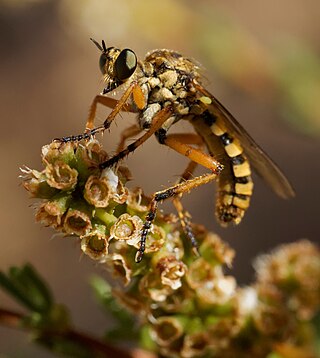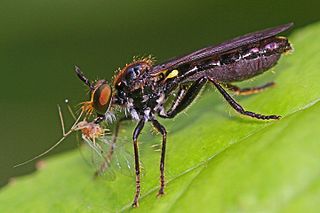
The silvery-cheeked hornbill is a large species of hornbill found in Africa. Silvery-cheeked hornbills are residents of the tall evergreen forests of East Africa from Ethiopia to South Africa. In Zimbabwe it is threatened by habitat destruction and its presence in South Africa is marginal, but it remains locally fairly common, especially in the northern and central parts of its range.
Levilactobacillus brevis is a gram-positive, rod shaped species of lactic acid bacteria which is heterofermentative, creating CO2, lactic acid and acetic acid or ethanol during fermentation. L. brevis is the type species of the genus Levilactobacillus (previously L. brevis group), which comprises 24 species. It can be found in many different environments, such as fermented foods, and as normal microbiota. L. brevis is found in food such as sauerkraut and pickles. It is also one of the most common causes of beer spoilage. Ingestion has been shown to improve human immune function, and it has been patented several times. Normal gut microbiota L. brevis is found in human intestines, vagina, and feces.

Karenia brevis is a microscopic, single-celled, photosynthetic organism in the genus Karenia. It is a marine dinoflagellate commonly found in the waters of the Gulf of Mexico. It is the organism responsible for the "Florida red tides" that affect the Gulf coasts of Florida and Texas in the U.S., and nearby coasts of Mexico. K. brevis has been known to travel great lengths around the Florida peninsula and as far north as the Carolinas.
Brevetoxin (PbTx), or brevetoxins, are a suite of cyclic polyether compounds produced naturally by a species of dinoflagellate known as Karenia brevis. Brevetoxins are neurotoxins that bind to voltage-gated sodium channels in nerve cells, leading to disruption of normal neurological processes and causing the illness clinically described as neurotoxic shellfish poisoning (NSP). Although brevetoxins are most well-studied in K. brevis, they are also found in other species of Karenia and at least one large fish kill has been traced to brevetoxins in Chattonella.

Monarda fistulosa, the wild bergamot or bee balm, is a wildflower in the mint family Lamiaceae, widespread and abundant as a native plant in much of North America. This plant, with showy summer-blooming pink to lavender flowers, is often used as a honey plant, medicinal plant, and garden ornamental. The species is quite variable, and several subspecies or varieties have been recognized within it. Despite its name, it has no relation to the 'true' bergamot, a citrus fruit.

Karenia is a genus that consists of unicellular, photosynthetic, planktonic organisms found in marine environments. The genus currently consists of 12 described species. They are best known for their dense toxic algal blooms and red tides that cause considerable ecological and economical damage; some Karenia species cause severe animal mortality. One species, Karenia brevis, is known to cause respiratory distress and neurotoxic shellfish poisoning (NSP) in humans.

Cryptotermes brevis is a species of termite in the family Kalotermitidae, commonly known as the West Indian drywood termite or the powderpost termite. It is able to live completely inside timber structures or articles made of wood such as furniture without any outside source of water. It is frequently introduced into new locations inadvertently, and causes damage to the structural timbers of buildings and to wooden objects such as furniture.

Stenopogoninae is a subfamily of robber flies in the family Asilidae. There are more than 70 genera and 740 described species in Stenopogoninae.

Oscillatoria brevis is a species of the genus Oscillatoria first identified in 1892. It is a blue-green filamentous cyanobacterium, which can be found in brackish and fresh waterways. O. brevis can also be isolated from soil.

Stenoscelis brevis is a species of snout or bark beetle in the family Curculionidae. It is found in North America.
Tepa brevis is a species of stink bug in the family Pentatomidae. It is found in Central America and North America.

Eudioctria is a genus of robber flies in the family Asilidae. There are about 14 described species in Eudioctria.

Cicurina brevis is a species of araneomorph spider in the family Dictynidae. It is found in the USA and Canada. A study from 2024 found this species alive under seasonal snowpack in a region called the subnivium in higher concentrations than it was found in the summer time, indicating a potential seasonal specialization for the winter.

Ephialtes is a genus of ichneumon wasps in the family Ichneumonidae. There are about 14 described species in Ephialtes.
Ospriocerus minos is a species of robber flies.
Eudioctria brevis is a species of robber flies in the family Asilidae.
Ospriocerus aeacus is a species of robber flies.
Ospriocerus latipennis is a species of robber flies.
Rhamphomyia brevis is a species of dance flies.
The Somali giant blind-snake or Somali giant blind snake, also known as the angle-snouted blind snake, is a species of snake in the Typhlopidae family. It is found in South Sudan, southern Ethiopia, Somalia, Uganda, northern Kenya and now in Tanzania.










